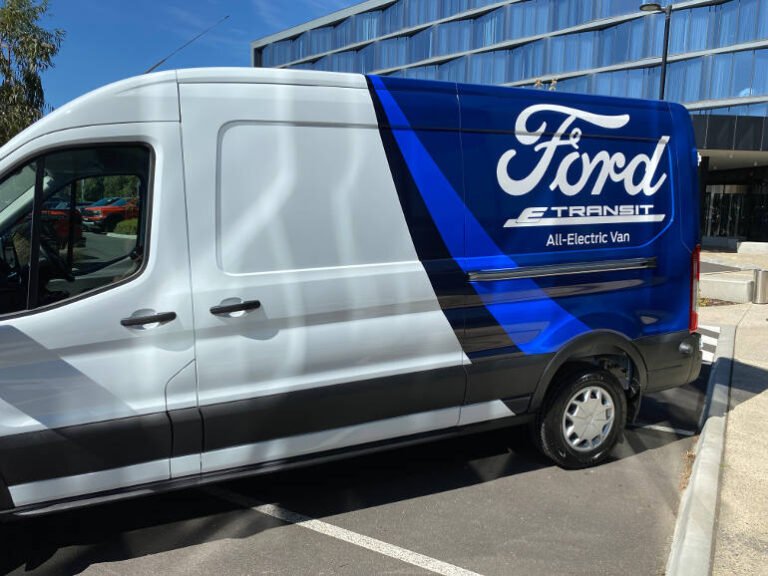It’s been over 12 months since Ford launched the E-Transit in Australia, and the response from fleet customers has been very encouraging, according to Christine Wagner, General Manager Fleet and Uplifting at Ford Australia.
Fleet EV New spoke with Wagner at the launch of the E-Transit Custom in Frankfurt Germany and learnt that from the moment the first E-Transit hit the roads, the interest and enthusiasm from fleet operators continued to grow, proving that Ford’s electric van is not just a novelty, but a viable and attractive option for commercial use.
The initial spark: curiosity and demand
The Transit series of vehicles have a well-established reputation globally for comfort, drivability, and dependability, with many businesses, both large and small, relying on them to for better productivity and return on their investment.
The initial response to the E-Transit was marked by curiosity and eagerness to test this new electric vehicle (EV). Ford Australia smartly addressed this interest by making demo units available for fleet customers to borrow. This approach allowed fleet managers to integrate the E-Transit into their operations temporarily, much like borrowing a library book. This extended loan period was crucial; unlike private buyers who might be satisfied with a brief test drive, fleet customers needed to see how the E-Transit performed over several weeks and under various conditions.
Positive feedback: comfort, performance, and practicality
The feedback from these extended test periods has been overwhelmingly positive. Drivers have praised the E-Transit for its comfort and smooth ride, whether it’s carrying a full load or running empty. The van’s ease of use has also been a highlight, simplifying the transition from traditional internal combustion engine (ICE) vehicles to electric.
Fleet managers have appreciated the chance to evaluate the E-Transit’s suitability for their specific use cases. This includes assessing its performance in terms of range, charging requirements, and overall efficiency. For many, the experience has confirmed that the E-Transit can meet their operational needs while also supporting their goals to reduce carbon emissions.
The practical appeal: size and capability
While the E-Transit fills a relatively niche segment in the Australian commercial vehicle market, its 11 cubic meters of enclosed space provides a practical solution for those who need significant cargo capacity without opting for a larger truck. This makes it an attractive option for a variety of businesses, from delivery services to trade professionals.
One of the critical questions for potential buyers has been whether the electric powertrain can match their expectations. Here, the E-Transit has excelled, demonstrating that it can deliver on both performance and sustainability. This is particularly important for fleet customers who are looking to align their operations with broader environmental objectives.
A catalyst for change: Driving the transition to EVs
The introduction of the E-Transit has sparked important conversations among fleet managers about how to evolve their business processes to take advantage of emerging technologies. Ford Australia has played a pivotal role in this transition, not just by providing the vehicles, but by supporting customers through the learning process. This collaborative approach has helped many organisations move from the initial curiosity phase to making informed purchasing decisions.
Several fleet customers have transitioned from borrowing an E-Transit to buying one or two units to integrate into their regular operations. This gradual adoption process allows businesses to experiment and refine their use of electric vehicles, ensuring a smoother transition and better long-term outcomes.
Looking ahead: The E-Transit Custom and market opportunities
The market potential for the E-Transit Custom is even more significant. This segment, which includes vans slightly smaller than the E-Transit, represents a substantial portion of the Australian commercial vehicle market. In 2023 alone, more than 20,000 vans were sold in this category, with the Transit Custom achieving a 14.1% market share.
The last few years have seen supply constraints impacting the true sales potential of the Transit Custom. In some cases, fleet buyers have had to turn to competitors simply due to availability issues, despite their preference for Ford vehicles.
For sole traders and larger fleets, their purchasing decisions are heavily influenced by reliability and uptime. Delivery-based operations, which form a major part of this market, cannot afford significant downtime, making reliability a key factor in vehicle selection. Here, the reputation and performance of the Transit Custom play a crucial role.
Navigating the EV adoption curve
A notable challenge for all manufacturers of is convincing small and medium businesses to consider electric vehicles. Unlike larger corporations, these businesses might not prioritise corporate emission reduction objectives. For them, the primary concern is whether the vehicle fits their operational needs and budget. However, if zero-emissions vehicles align with their brand values, the E-Transit Custom becomes a compelling choice.
The E-Transit Custom offers several practical advantages that help overcome common barriers to EV adoption. One key feature is its height, which is under two metres, allowing it to access public charging stations in shopping centres. This flexibility is a significant benefit for businesses that need reliable and convenient charging options.
In its first year on Australian roads, the Ford E-Transit has proven itself as a worthy contender in the commercial vehicle market. The positive feedback from fleet customers, coupled with the practical benefits and growing interest in electric vehicles, suggests a bright future for Ford’s electric van lineup.
As more businesses experience the benefits of the E-Transit and E-Transit Custom, the market can expect to see a continued shift towards sustainable and efficient fleet operations. Ford Australia is not just keeping pace with this transition but is actively driving it forward.






